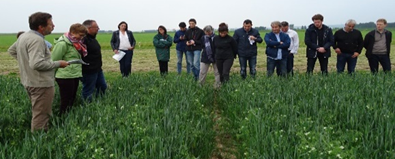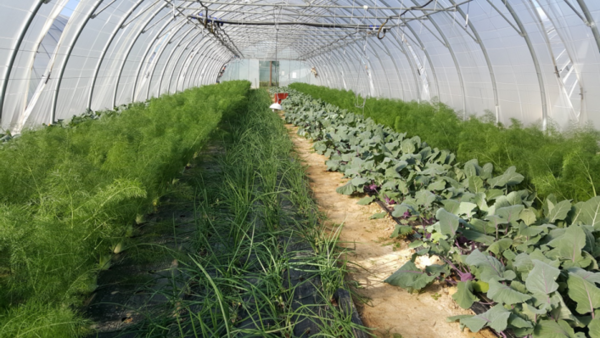In DiverIMPACTS, different cropping systems combining temporal and spatial diversification were designed and are being tested in a network of ten field experiments in Europe. Spatial diversification consists of growing two or more species together on the same field. By contrast, temporal diversification extends the length of the crop rotation to add new cash crops and cover crops. In current cropping systems in Europe, temporal diversification is more prominent than spatial diversification, meaning that fields are often genetically uniform.
However, increasing crop diversity within the field could improve pest and disease control. For example, adding a species to another one can provide a physical barrier to the spread of diseases or attract natural enemies to pests. It can also help to suppress weeds, as less resources are available for weeds when light and nitrogen are used more effectively by a mixture of species with contrasting traits. Spatial diversification, especially in cropping systems that are less dependent on external inputs, can also increase crop productivity and its stability through different mechanisms.
The reference systems in the network of field experiments, which represent current cropping systems in different European climatic contexts, do not have spatial diversification. In the diversified systems, all field experiment leaders apply different strategies of spatial diversification. On average, 37% of the cash crops in the crop rotation are grown using intercropping.
The main strategy of spatial diversification used in the cropping systems tested in DiverIMPACTS is cereal-grain legume intercropping (present in half of the experiments), such as pea-barley, pea-wheat (photo 1) and lupin-oat intercrops. The two species are sown and harvested together. The first results highlight that these intercrops have a positive effect on yield as shown by land equivalent ratio (LER) values higher than one in several sites (i.e. more land would be required to produce the same yield without intercropping). The results confirm that intercropping tends to be a relevant practice for weed suppression, especially in organic agriculture. Moreover, several sites suffered from a severe and unusual drought during the first experimental year, and it seems that intercropping can secure yield in the case of hard conditions compared to sole crops, which are more sensitive to such constraints. At this stage, intercropping can be strongly encouraged as a way to facilitate the production of legumes or other species known for their high inter-annual yield variability and sensitivity to different biotic and abiotic factors.
Three sites explore strip cropping (several species in the same field but grown in separate strips). In these experiments, positive effects on yield have also been observed. For example, in Italy, (field experiment 9), LER values up to 1.4 were obtained with an innovative system of temporal strip cropping, including tomato and faba bean. In the Netherlands (field experiment 7), cabbage-wheat strip cropping also showed promising results. Strip cropping is seen as a relevant way to influence different ecosystem services such as attracting natural enemies. Strip cropping is also studied in innovative vegetable systems in tunnels in France (field experiment 10) (photo 2) to see its impact on different criteria: providing a variety of vegetables that are demanded by consumers while also providing different ecosystem services (e.g., pest control, improvement of soil quality).
Other types of spatial diversification are included in the diversified systems tested. A cover crop is sometimes added to the main crop for its expected ecosystem services but is not harvested. For example, oilseed rape is intercropped with frost legumes in two sites to increase weed control and to improve nitrogen availability for the main crop. Finally, in four sites, undersowing is used in the cropping systems. Instead of sowing a species (e.g. alfalfa) alone in bare soil, it is sown into an existing crop (e.g., sunflower) and remains after the harvest of its companion. Alfalfa sown with sunflower has had positive results in France (field experiment 5).
The difficulties experienced by the network regarding the different crop diversification strategies have also been recorded (e.g., crop management, machinery issues) and will help with mutual learning on crop diversification and the identification on new research and operational questions.
These first results have been shared with partners of the European cluster on crop diversification, especially Remix, Diversify and Diverfarming, during the European Conference on Crop Diversification held in Budapest in September this year. In the next years, additional results will give rise to new arguments, and we will investigate the benefits of the combination of temporal and spatial diversification, which were usually studied separately in previous projects.



 tap and then scroll down to the Add to Home Screen command.
tap and then scroll down to the Add to Home Screen command.